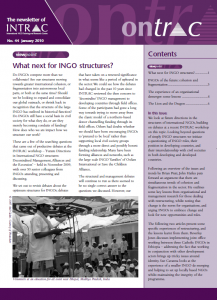 In this issue on Ontrac we look at future directions in the structures of international NGOs, building on debates at a recent INTRAC workshop on this topic. Looking beyond questions of simply INGO structures we initiate a questioning of INGO roles, their position in developing countries, and their interrelationship with civil societies in both developing and developed countries.
In this issue on Ontrac we look at future directions in the structures of international NGOs, building on debates at a recent INTRAC workshop on this topic. Looking beyond questions of simply INGO structures we initiate a questioning of INGO roles, their position in developing countries, and their interrelationship with civil societies in both developing and developed countries.
Following an overview of the issues and trends by Brian Pratt, John Hailey puts forward an argument that there are simultaneous trends of cohesion and fragmentation in the sector. He outlines some key lessons from organisational and management research for those dealing with restructuring, whilst noting that change is the norm for organisations, and urging INGOs to embrace change and look for new opportunities and roles.
The following two articles present some specific experiences of restructuring, and the lessons learnt from them. Beverley Jones discusses implementing joint office working between three Catholic INGOs in Ethiopia – addressing the fact that working in conjunction with other development actors brings up tricky issues around identity. Sue Cavanna looks at the experience of a smaller INGO de-merging and helping to set up locally based NGOs whilst maintaining the integrity of the programme.
Download:
ONTRAC 44. What Next for INGO Structures?
.pdf (1.64mb)
Download:
ONTRAC 44. What Next for INGO Structures? French
.pdf (0.07mb)
Download:
ONTRAC-44-Portuguese-What-Next-for-INGO-Structures-2010
.pdf (0.08mb)
Download:
ONTRAC 44. What Next for INGO Structures? Russian
.pdf (0.35mb)
Download:
ONTRAC 44. What Next for INGO Structures? Spanish
.pdf (0.09mb)